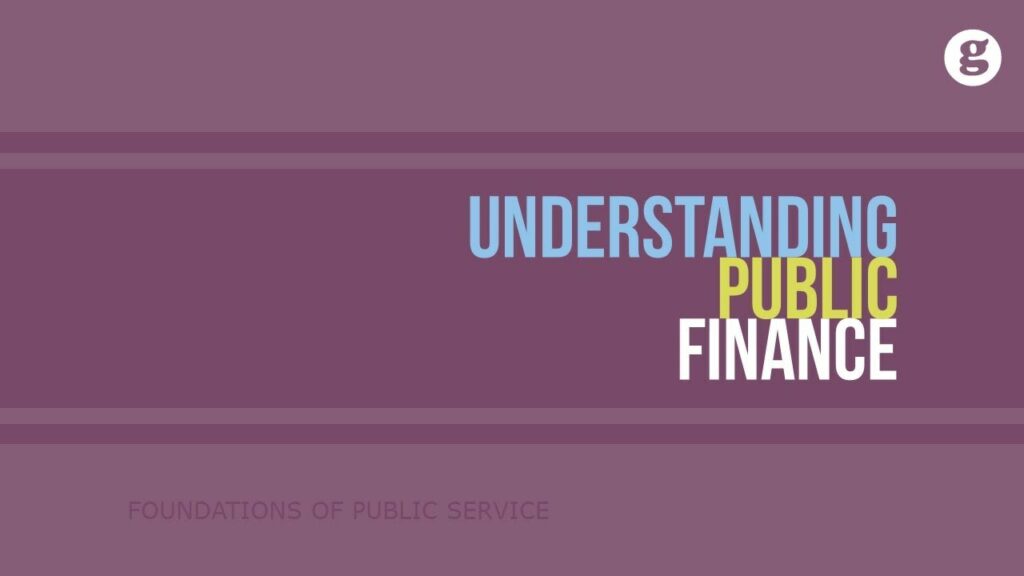Toggle light
Comments
94 Views
Report
Favorite
If current server doesn't work please try other servers below.

Score: 10 / 5 rated
Understanding Public Finance: Concepts, Importance, and Applications
Understanding Public Finance: Concepts, Importance, and Applications
Public finance is a critical area of economics that deals with the management of government revenues, expenditures, and debt. It directly impacts the economic health of a country, influencing policies that affect individuals, businesses, and society as a whole. From the taxes individuals pay to the government’s expenditure on public goods and services, public finance plays a significant role in shaping the overall economy.
In this comprehensive guide, we will delve into the key concepts, principles, and importance of public finance. We will also discuss its various functions, including revenue generation, budgeting, government expenditure, and fiscal policy. This article will provide you with a deeper understanding of public finance and its importance in maintaining economic stability and growth.
What Is Public Finance?
Public finance is the study of the role of the government in the economy. It is concerned with how the government collects and spends money and how these actions affect the economic well-being of a country. In simpler terms, it focuses on the financial activities of the public sector, such as tax collection, government spending, and managing public debt.
Public finance plays a key role in ensuring that governments can provide essential public goods and services like education, healthcare, infrastructure, and national defense. It also involves the management of government policies related to taxation, public expenditure, borrowing, and fiscal deficit control.
Public finance is divided into three major areas:
- Public Revenues: This includes all the ways in which the government generates income, primarily through taxation (income tax, sales tax, excise duties, etc.), but also through borrowing and other forms of revenue such as fees, fines, and grants.
- Public Expenditures: This refers to the allocation of government funds to various public services, infrastructure, subsidies, and social security programs. Public spending is typically categorized into capital expenditures (for infrastructure, public works) and recurrent expenditures (such as salaries, social benefits).
- Public Debt: When a government borrows money to finance its activities, it accumulates public debt. This area involves the management of government borrowing and repayment, as well as controlling fiscal deficits.
Key Concepts in Public Finance
There are several key concepts in public finance that help define its scope and influence its practical application. Here are some of the essential concepts:
1. Taxation
Taxation is one of the primary tools of public finance, and it refers to the process by which governments collect funds from citizens and businesses. Taxes can be classified into several types:
- Direct Taxes: These are taxes levied on individuals and businesses, such as income tax, corporate tax, and wealth tax.
- Indirect Taxes: These are taxes on goods and services, such as sales tax, value-added tax (VAT), and excise duties.
Taxes are the main source of revenue for governments and are used to finance public expenditure and public goods and services.
2. Fiscal Policy
Fiscal policy is the use of government spending and tax policies to influence economic conditions. Governments use fiscal policy to stabilize the economy by controlling inflation, promoting economic growth, reducing unemployment, and managing public debt.
There are two types of fiscal policies:
- Expansionary Fiscal Policy: This policy is used when an economy is in a recession or experiencing slow growth. The government increases its spending or reduces taxes to stimulate demand and boost economic activity.
- Contractionary Fiscal Policy: This policy is used to slow down an overheating economy or curb inflation. The government reduces spending or increases taxes to decrease overall demand.
The right balance of fiscal policy is essential for economic stability. If fiscal policies are too expansionary, they can lead to inflation, while overly contractionary policies can lead to recessions.
3. Budgeting
Budgeting is the process by which governments allocate their financial resources to different sectors of the economy. It involves projecting government revenues and expenditures for a specific period (usually a fiscal year).
Budgets are typically divided into:
- Annual Budget: This is the yearly plan for government income and expenditure. It outlines the government’s priorities and allocation of resources across various sectors such as healthcare, education, and defense.
- Capital Budget: This part of the budget deals with long-term investments, such as infrastructure projects, building roads, and setting up public utilities.
- Current Budget: This focuses on day-to-day government spending on public goods and services like healthcare, public education, and defense operations.
Effective budgeting ensures that the government’s resources are used efficiently to meet public needs while ensuring fiscal responsibility.
4. Public Debt
Public debt arises when a government borrows money to meet its expenditure obligations. This could be through bonds, loans from international organizations, or domestic borrowing. Public debt can be a tool for funding capital projects, such as building infrastructure or financing other long-term investments.
However, managing public debt is essential to avoid the negative consequences of excessive borrowing, such as higher interest payments and potential fiscal instability. Governments must strike a balance between borrowing to fund necessary projects and maintaining a sustainable debt-to-GDP ratio.
The Importance of Public Finance
Public finance plays a crucial role in the functioning of any economy. Its importance extends far beyond merely balancing government budgets; it influences economic development, income distribution, and social welfare. Here are some of the key reasons why public finance is important:
1. Efficient Resource Allocation
Public finance allows for the efficient allocation of resources in the economy. Governments use their fiscal policies to redistribute wealth and promote economic equality. Through mechanisms such as progressive taxation and welfare programs, public finance helps reduce income inequality, ensuring that wealth is more evenly distributed among the population.
Governments also invest in public goods and services that private markets may not provide efficiently, such as national defense, infrastructure, education, and healthcare. These services contribute to the overall well-being of the population and promote social stability.
2. Economic Stability and Growth
Public finance ensures that governments can manage economic fluctuations by using fiscal policy tools. When the economy is in a downturn, governments can implement expansionary fiscal policies to stimulate demand and economic activity. Conversely, when the economy is overheating and inflation is rising, contractionary fiscal policies can help to control inflation and maintain long-term stability.
Additionally, through investments in infrastructure, education, and technology, public finance can foster long-term economic growth. Governments that manage public finance effectively create an environment conducive to innovation, entrepreneurship, and overall economic development.
3. Social Welfare
Public finance is crucial in supporting social welfare programs that ensure citizens have access to essential services such as healthcare, education, housing, and unemployment benefits. These programs are vital for improving the quality of life for individuals, particularly for those who are most vulnerable.
Governments allocate resources through public finance to ensure that there is a safety net for those in need. Without effective public finance management, essential services may be underfunded or inefficiently delivered, leading to social inequality and unrest.
4. Managing National Debt
Public finance helps governments manage and service their national debt. Excessive debt can pose a serious risk to a country’s economy, affecting its credit rating and increasing borrowing costs. By maintaining a balanced budget, managing expenditures wisely, and using debt strategically for investments that promote growth, public finance helps ensure long-term fiscal health.
Effective debt management can also help governments navigate crises such as financial recessions, natural disasters, or wars without resorting to drastic austerity measures that could harm the economy.
Functions of Public Finance
The primary functions of public finance are:
1. Revenue Generation
Governments need a steady and reliable flow of income to fund public services and programs. Public finance enables governments to determine the best ways to generate revenue through taxation and borrowing. Taxation ensures that governments can meet the needs of their citizens by providing essential services such as healthcare, education, and infrastructure development.
2. Public Expenditure
Once revenue is generated, governments must decide how to allocate the funds. Public finance ensures that expenditures are made in areas that benefit society, such as public health, infrastructure, education, and security. Effective management of public expenditure helps ensure that the government meets its social and economic goals.
3. Debt Management
Managing government debt is a critical function of public finance. Governments must determine how to borrow money and how much debt is sustainable without burdening future generations. Public finance experts evaluate the costs and benefits of borrowing, considering both short-term and long-term economic implications.
4. Redistribution of Wealth
Public finance plays a role in redistributing wealth and reducing economic inequalities through progressive taxation systems and welfare programs. By collecting taxes from higher-income individuals and redistributing them to lower-income groups, governments can help alleviate poverty and promote social equity.
Public Finance in Practice: Real-World Examples
To better understand the role of public finance, let’s look at how it is applied in real-world situations.
Example 1: Health and Education Funding
A government allocates a portion of its revenue to fund universal healthcare and education systems. These public services ensure that citizens have access to essential services regardless of their income level, contributing to a healthier and more educated population. The allocation of public funds is carefully managed to meet the growing demands for these services.
Example 2: Infrastructure Projects
Governments often use public finance to fund large-scale infrastructure projects such as highways, public transportation systems, and airports. By borrowing money or using public funds, governments invest in infrastructure that promotes economic growth and improves the quality of life for citizens.
Conclusion
Public finance is a cornerstone of any country’s economic framework. It enables governments to allocate resources efficiently, stabilize the economy, and support social welfare. By managing revenues, expenditures, and debt responsibly, governments can create a conducive environment for economic growth, prosperity, and social equity.
Whether you’re an economist, policymaker, or citizen, understanding the principles and applications of public finance is essential for appreciating how governments shape the economic landscape and influence the lives of individuals. Proper management of public finances leads to a more prosperous and stable society, ensuring that public services meet the needs of the population and foster long-term growth.
Post Views: 7
Genre: Blog
Director:
You may also like
Report Content
Understanding Public Finance: Concepts, Importance, and Applications
Movie












